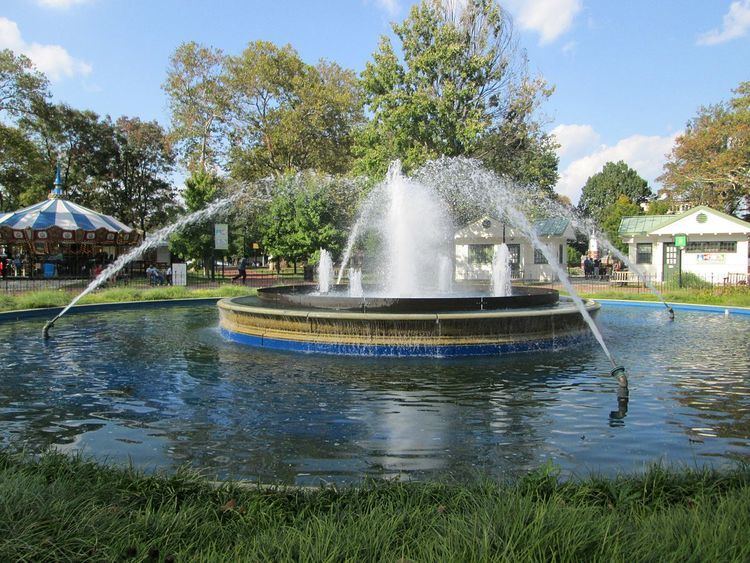Area 7.5 acres (3.0 ha) | Built 1683 Phone +1 215-629-4026 | |
 | ||
Hours Open today · 10AM–7PMThursday10AM–7PMFriday10AM–9PMSaturday10AM–9PMSunday10AM–7PMMonday10AM–7PMTuesday10AM–7PMWednesday10AM–7PM Similar Please Touch Museum, Congress Hall, Independence Hall, Liberty Bell, Philadelphia City Hall | ||
Franklin Square is one of the five original open-space parks planned by William Penn when he laid out the city of Philadelphia, Pennsylvania in 1682. It is located in the Center City area, between North 6th and 7th Streets, and between Race Street and the Vine Street Expressway (I-676).
Contents
The park went through a period of deterioration, but was refurbished and revitalized in 2006. It is now managed by Historic Philadelphia, a non-profit organization.
Franklin Square was added to the National Register of Historic Places (NRHP) in 1981.
History
Originally called North East Publick Square, Franklin Square was renamed in 1825 to honor Benjamin Franklin, one of the Founding Fathers of the United States. In its early years, the square was an open common used for grazing animals, storing gunpowder during the American Revolution and drilling soldiers during the War of 1812. From 1741 to 1835, a portion of the Square was used as a cemetery by the German Reformed Church; some of the graves still remain, marked by a plaque.
In the 19th and early 20th centuries, Franklin Square was at the center of a fashionable residential neighborhood; but beginning in the 1920s, a series of events corresponding with the rise of the automobile began the decline of the Square and its surrounding neighborhood. The construction of the Ben Franklin Bridge, from 1922–26, leveled blocks of row homes, shops and other structures; the Bridge begins at the Square’s eastern boundary, 6th Street. The steady flow of cars over the bridge made Franklin Square’s northern boundary, Vine Street, into one of the city’s busiest thoroughfares, effectively cutting off pedestrian access on two of the Square's sides.
In 1961, writer Jane Jacobs labeled Franklin Square "the city's Skid Row park," a description that fit for decades. The neighborhood’s residential character was further eroded when the Federal government established Independence Mall. The government acquired private land around the Square in the 1950s and 1960s and demolished blocks of homes and other buildings. The construction of the Vine Street Expressway in the late 1980s exacerbated the problem. Franklin Square became the least-used of Penn’s original five squares, and served mainly as an encampment for the homeless.
From 2003 to 2006, the park was refurbished by Historic Philadelphia, Inc. — a non-profit company responsible for the Betsy Ross House and several other historical sites — in a $5.5 million project funded primarily by a grant from the state of Pennsylvania. It was reopened and rededicated on July 31, 2006, in Franklin’s tercentenary year. The revitalized park contains a number of family-friendly attractions.
Recently, a lot of re-development activities around the Franklin Square area has included new housing, commercial, and office spaces, and in the Northern Liberties neighborhood to its north and the redevelopment of the shuttered Metropolitan Hospital as a condominium project. As a result, pedestrian traffic has increased dramatically.
In 2009, the Delaware River Port Authority (DRPA) announced that it was commissioning a design plan for renovating, modernizing and reopening the PATCO Speedline's underground Franklin Square Station, closed since 1979. As a result of ongoing capital projects scheduled to continue through 2016, PATCO stated in 2014: "We do not presently have the capacity or capital resources to evaluate the feasibility of reopening the Franklin Square Station."
Bolt of Lightning
Local legend maintains that Franklin Square is where Benjamin Franklin conducted his famous, though misunderstood, "kite and key" experiment in 1752. However, it would have been unlikely for Franklin to fly a kite near a cemetery, and not all that far from possible observers from town. The legend is memorialized in Isamu Noguchi’s Bolt of Lightning... A Memorial to Benjamin Franklin, a 101-foot tall, 60-ton stainless steel sculpture commissioned by the Fairmount Park Art Association and costing $850,000. It was erected in 1984 in Monument Plaza at the base of the Ben Franklin Bridge, facing the Square across 6th Street, a location personally chosen by Noguchi.
Noguchi had first proposed the sculpture in 1933, but the idea was rejected then as being too radical. The sculpture, which depicts a kite, a bolt of lightning and a key, is not universally admired. In 1984, the Philadelphia Inquirer said about it:
It shrinks in its plaza before the bridge, inaccessible to pedestrians and, for motorists, a sliver out-dazzled by a parade of billboards announcing the sizzle of Atlantic City. It is a crumpled, bent-can of a sculpture, in the end, a symbol more of the dispirited swatch of Vine Street it concludes; a propped-up monument to a city that, like Rodney Dangerfield, has had — and, with this piece of art, may continue to have — one tough time getting respect.
Columnist Larry Mendte called it "the ugliest piece of art in Philadelphia" and "a bizarre eyesore".
